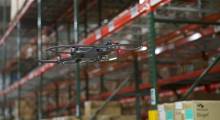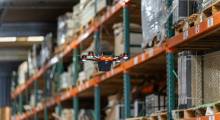Amazon has received a lot of attention for its plans to use robotic drones to deliver packages, but there are other, potentially more economically feasible, uses for autonomous drones in the supply chain. Sabrewing Aircraft Co., for example, has developed a pair of cargo carrier drones designed for large payloads (up to 800 lbs.) that could be used to move goods in transportation hubs (like shipping yards or airports).
The company recently received more than $2 million in funding from the Drone Fund, Idaten Ventures, and other investors to complete construction of a full-sized, pre-production prototype of its Rhaegal air vehicle. Preliminary flight tests are expected to begin this year, pending Series A round of funding in the third quarter.
Sabrewing has designed its cargo drones for disaster/emergency response, forward-operating-position resupply applications, and potentially casualty evacuation in a military use case. The drones can also deliver commercial cargo to locations not serviced by airports or roads.
Modeling and Testing
Currently, the company has produced a 1/8-scale model of the aircraft and is actively testing its flight characteristics. Sabrewing also opened offices in Tokyo. It is designed to deliver an 800-lb. payload at altitudes of up to 22,000 ft. and at a range of up to 360 nautical miles (670 km). The wings can fold and retract both on the ground (for handling and storage) and in the air if the craft has to land in tight spaces. It also has a folding nose door that enables easy loading and unloading of cargo without special equipment.
The company was able to create the scale model relatively rapidly, although according to company CEO Ed De Reyes, the design has been in the works for some 15 years. “We have done multiple scale models and achieved the design, so we went and starting pitching the idea here in the U.S., but didn’t get a lot of traction,” De Reyes says. “We started working in Japan, and that was when we got our initial funding and finalized a lot of the engineering work we had to do.”
Sabrewing has also developed a larger Wyvern aircraft that can handle a 4,400-lbs. payload.
The Rhaegal is a gas-electric hybrid with vertical take-off and landing capabilities and can reach speeds of up to 370 km/hour in poor weather conditions. According to the company, the craft can be remotely piloted for commercial operations, and fully autonomous in military applications.
Both designs are in the same class as the Cessna 208 Caravan aircraft and other vehicles, and FAA certification of the Rhaegal could come as soon as 2023.
Use of CAD and Simulation Software
The company did finite element analysis and computational fluid dynamics simulation work on the design, as well as comprehensive independent verification and validation and a critical design review. “It was based on the testing we did on that final model that convinced the investors this was definitely viable,” De Reyes says.
Sabrewing currently uses Dassault Systemes SolidWorks internally and shares files with its partners via a cloud connection. “We’re writing some of our own software as well, and relying on Oklahoma University software, as well as software being developed by the University of California, Channel Islands,” De Reyes says. “We have a core team here of about 10 people, and another 36 engineers working on this through our partnerships.”
Sabrewing has also leveraged the X-Plane flight simulator to test the aircraft. “People sometimes raise their eyebrows at that, because of it’s reputation as a game, but it can also be used extensively as a simulator,” De Reyes says. “We can use it to build a very detailed model, and our autopilot manufacturer uses it too. We can go back and refine the fidelity based on what we see in those simulations. It’s been a very useful tool.”
The aircraft use a five-sensor detect and avoid (D&A) system to autonomously navigate around obstacles and air traffic. That system was built in collaboration with the University of California Channel Islands; Oklahoma University; Garmin; FLIR; uAvionix; Iris Automation; and Attollo Engineering.
The scale model was built, in part, using Onyx 3D printing filament and carbon fiber from Markforged.
According to De Reyes, a full-size aircraft is in the works and could be finished by October 2019. The aircraft is built in five sections using a composite tube frame. “The fuselage skins get beat up and damaged quite easily, so we can hang the skins off those tubes and if they get damaged they can be easily repaired or replaced in the field,” De Reyes says.
An ongoing challenge has been finding batteries that can be used in this type of hybrid configuration, as well as obtaining sufficient venture funding. “U.S. investors want to see a very high return, but that’s not the case in Japan,” De Reyes says. “they are willing to be more patient than VCs in the U.S., and they really grasp the potential of this market. We’re not competing with the Cessnas and Boeings of the world. This is really a niche market.”
Initial testing of the full-size prototype will take place in Alaska, where De Reyes thinks this type of cargo plane can be well utilized. “Only 17% of communities there are served by roads or even airports,” De Reyes says. “The FAA is amenable a type of provisional certificate that allows us to operate in Alaska. If we can show safe operations in a sparsely populated area, then I think that will get us the ability to operate in the lower 48.”
About the Author
Follow Robotics 24/7 on Linkedin
Article topics
Email Sign Up
















